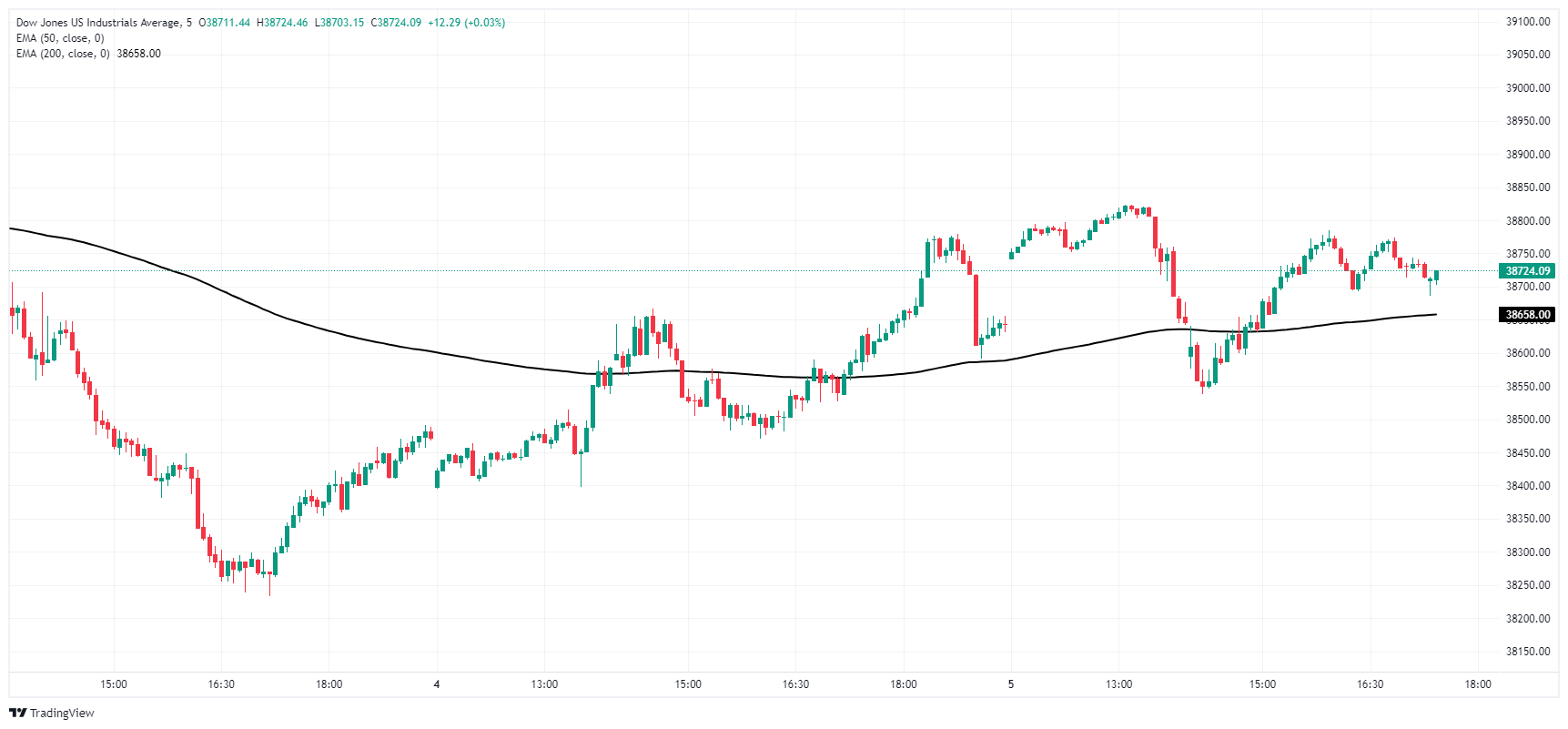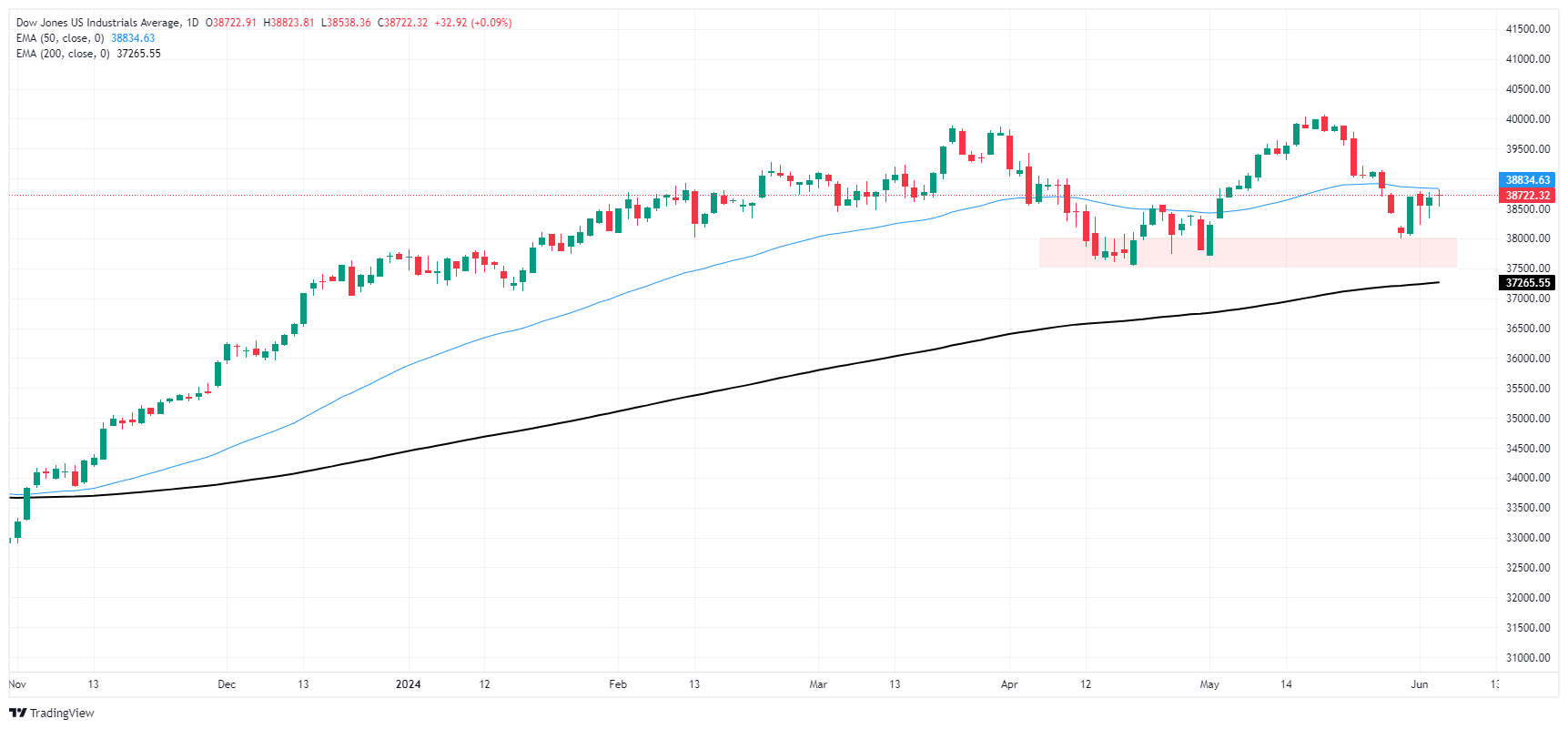- Dow Jones trades around 38,700.00 after US ADP data
- The US ISM services PMI accelerated to multi-month highs.
- Mixed data hinted at enough softness to further bolster rate cut hopes.
The Dow Jones Industrial Average (DJIA) is steady on Wednesday, trading at 38,750.00. After US data came in mixed, rate cut expectations remained on the high side, but gains in the Dow Jones remain limited.
The US ADP employment change in May was reduced to 152,000 compared to the forecast of 173,000, and the previous month’s figure also saw a downward revision to 188,000 from 192,000. The US ISM services Purchasing Managers’ Index (PMI) jumped to a nine-month high of 53.8, well above the forecast of 50.8 and surpassing the previous 16-month low of 49.4.
Despite a healthy rebound in services activities, markets are focusing on the cooling effect of declining ADP labor numbers. According to the CME’s FedWatch tool, rates markets are pricing the odds of a rate cut of at least 25 basis points at the Federal Reserve’s (Fed) September rate meeting at 80%.
Broader markets will be pivoting to look ahead to Friday’s upcoming US Nonfarm Payrolls (NFP) report, which is forecast to rise to 185,000 from 175,000 the previous month. With rate cut hopes again on the high side, investors will be looking for a softer NFP report and downward revisions to previous numbers.
Dow Jones News
The Dow Jones is holding steady on Wednesday, with about half of the index’s stocks in the green during the midweek market session. Intel Corp (INTC) rose around 2.0%, topping $30.00 per share. On the low end, Cisco Systems Inc. (CSCO) fell -3.26% to $45.88 per share on Wednesday, falling to a new 52-week low as investors remain skeptical about the profitability of the new internet monitoring unit powered by Cisco System AI, ThousandEyes. Cisco’s ThousandEyes is presented as an automated security and internet mapping tool.
Dow Jones Technical Outlook
The Dow Jones is trading near 38,700.00 on Wednesday as the main stock index struggles to share the gains found by similar US indexes. The DJIA is struggling under the weight of short-term losses after falling from all-time highs by above 40,000.00.
The daily candlesticks are touching a supply zone below 38,000.00, and long-term technical support is valued at the 200-day exponential moving average (EMA) at 37,297.33. The Dow Jones has halted a near-term decline but still remains -3.35% below all-time high bids set in mid-May.
Dow Jones Five Minute Chart
Dow Jones Daily Chart
The Dow Jones
The Dow Jones Industrial Average, one of the world’s oldest stock indices, is made up of the 30 most traded securities in the United States. The index is weighted by price rather than capitalization. It is calculated by adding the prices of the securities that comprise it and dividing them by a factor, currently 0.152. The index was founded by Charles Dow, also founder of the Wall Street Journal. In recent years it has been criticized for not being sufficiently representative, since it only follows 30 companies, unlike broader indices such as the S& P 500.
There are many factors that drive the Dow Jones Industrial Average (DJIA). The main one is the aggregate performance of its component companies, revealed in quarterly corporate earnings reports. US and global macroeconomic data also contribute, influencing investor sentiment. The level of interest rates, set by the Federal Reserve (Fed), also influences the DJIA, as it affects the cost of credit, on which many companies largely depend. Therefore, inflation can be a determining factor, as well as other parameters that influence the decisions of the Federal Reserve.
The Dow Theory is a method for identifying the main trend of the stock market developed by Charles Dow. A key step is to compare the direction of the Dow Jones Industrial Average (DJIA) and the Dow Jones Transportation Average (DJTA) and only follow trends where they are both moving in the same direction. Volume is a confirmation criterion. The theory uses elements of maximum and minimum analysis. The Dow theory proposes three phases of the trend: accumulation, when the smart money begins to buy or sell; public participation, when the general public joins the trend; and distribution, when the smart money abandons the trend.
There are several ways to trade the DJIA. One of them is to use ETFs that allow investors to trade the DJIA as a single security, instead of having to buy shares of the 30 companies that comprise it. A prominent example is the SPDR Dow Jones Industrial Average ETF (DIA). Futures contracts on the DJIA allow traders to speculate on the future value of the index, and options provide the right, but not the obligation, to buy or sell the index at a predetermined price in the future. Mutual funds allow investors to purchase a portion of a diversified portfolio of DJIA securities, providing exposure to the global index.
Source: Fx Street
I am Joshua Winder, a senior-level journalist and editor at World Stock Market. I specialize in covering news related to the stock market and economic trends. With more than 8 years of experience in this field, I have become an expert in financial reporting.







